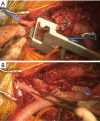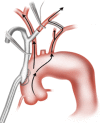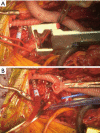Classic hybrid arch debranching (type I hybrid arch repair) without circulatory arrest
- PMID: 30155426
- PMCID: PMC6094021
- DOI: 10.21037/acs.2018.05.06
Classic hybrid arch debranching (type I hybrid arch repair) without circulatory arrest
Conflict of interest statement
Conflicts of Interest: The author has no conflicts of interest to declare.
Figures













References
Publication types
LinkOut - more resources
Full Text Sources
Other Literature Sources
